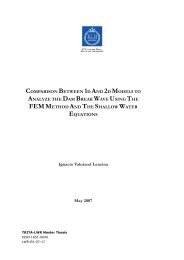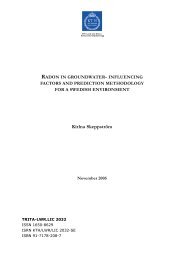Water <strong>sources</strong>, <strong>infrastructure</strong>, <strong>space</strong> <strong>and</strong> <strong>the</strong> <strong>dynamics</strong> <strong>of</strong> environmental diseases in Saboba District: Using GISInterviewsA number <strong>of</strong> persons representing various departments <strong>and</strong> units <strong>of</strong><strong>the</strong>ir respective <strong>of</strong>fices were interviewed. These included <strong>the</strong> MedicalAssistant (Wapuli Health Centre), Claim Officer (National HealthInsurance Scheme, Saboba), Operator (Saboba Community Waterdistribution plant), Head <strong>of</strong> <strong>the</strong> District Environmental Health unit (for<strong>the</strong> former Saboba-Chereponi District) <strong>and</strong> some individuals. Theinterviews with <strong>the</strong> individuals such as chiefs, elders <strong>and</strong> opinion leaderswere unstructured type.CHAPTER 3Results <strong>and</strong> discussionData ga<strong>the</strong>red from <strong>the</strong> field survey between August <strong>and</strong> October (2007)are presented <strong>and</strong> analysed in this section. The data are both secondary<strong>and</strong> primary (from personal field survey using questionnaires <strong>and</strong>interviews). The cross tabulation <strong>of</strong> respondents answers is done usingStatistical Package for Social Sciences (SPSS). The questionnaires wereadministered to 130 respondents in five selected areas: CentralTownship, Toma <strong>and</strong> Chief-section, which form <strong>the</strong> Saboba town(bigger town) <strong>and</strong> its environs, Wapuli (a small town) <strong>and</strong> Bordagbalm (avillage). Chief-section area for <strong>the</strong> purpose <strong>of</strong> this study extended from<strong>the</strong> Chief-section itself, Borgbaln, Tilangbeni to Borkuln, while Tomaalso included Na-logni, Lower Kakpeni <strong>and</strong> its surroundings.Field problemsLike any social science research, this study faced problems such asunwillingness by some few respondents who normally perceive questionslike this as a mechanism to impose tax on <strong>the</strong>m. The problem also arosebecause <strong>the</strong> people complained that a lot <strong>of</strong> studies have asked for suchinformation but nothing has been done. One o<strong>the</strong>r problem was <strong>the</strong>issue <strong>of</strong> getting as many women willing to answer questionnaires, as in<strong>the</strong>ir views, questions concerning <strong>the</strong> area was primarily under men’sauthority. The more rural an area was, <strong>the</strong> more this constituted aproblem. The strategy used to address <strong>the</strong>se concerns was to firsteducate <strong>the</strong> people that <strong>the</strong> research was purely academic <strong>and</strong> assurancethat <strong>the</strong> information <strong>the</strong>y provide will be h<strong>and</strong>led confidentially.Basic characteristics <strong>of</strong> respondentsTable 1a shows <strong>the</strong> number <strong>of</strong> respondents by place <strong>and</strong> sex. Thenumber <strong>of</strong> respondents was proportionate to <strong>the</strong> total population <strong>of</strong>each selected area. The table shows that 61.5% <strong>of</strong> <strong>the</strong> respondents weremales while 38.5% were females. In all <strong>the</strong> selected areas, <strong>the</strong> number <strong>of</strong>males is more than that <strong>of</strong> females, except in Chief-section area where53.3% were females as against 46.7% males. The variation in <strong>the</strong> sexesmay be due to <strong>the</strong> fact that issues concerning human welfare <strong>and</strong> <strong>the</strong>society in <strong>the</strong> communities are presumably under men’s authority in <strong>the</strong>district.Table 1b also shows that Saboba district is predominantly youthfulpopulation as 41.5% <strong>of</strong> <strong>the</strong> respondents are between 14 <strong>and</strong> 20 years,35.4% (20-29) <strong>and</strong> only 3.1% are between 70 <strong>and</strong> 79 years.Table 2 shows that 27% (34) <strong>of</strong> <strong>the</strong> respondents have no education,5.6% (7) had basic education, 10.3% (13) for Junior High School (JHS)or Middle School (MS) <strong>and</strong> 48.4% (61) attended Senior High School(SHS). However, <strong>the</strong> level <strong>of</strong> education reduced to 4.8% (6) forTeacher/Nursing Training College (TTC/NTC) <strong>and</strong> 4% (5) had auniversity degree.15
Mat<strong>the</strong>w Biniyam KursahTRITA LWR Master ThesisTable 3 shows that 45.6% (57) <strong>of</strong> <strong>the</strong> respondents were students <strong>and</strong>33.6% (42) are engaged in farming. There is low unemployment rate asonly 3.2% (4) identified <strong>the</strong>mselves as unemployed.Disease pattern in Saboba districtA four-year trend <strong>of</strong> <strong>the</strong> top 10 diseases in <strong>the</strong> district from 2002 to 2005show a dramatic increases in <strong>the</strong> rates <strong>of</strong> disease prevalence; with 57.5%for Malaria, diarrhoeal diseases (58.6%), RTI (422.7%), intestinal worms(1481.5%) <strong>and</strong> Typhoid from 161 to 7,725, giving 4698.1% increase(Table 4). More surprisingly, Typhoid has gained <strong>the</strong> second top positionin disease prevalence in <strong>the</strong> district as at September 2007 (Table 5).Figure 4 depicts how <strong>the</strong> trend <strong>of</strong> diseases will have being (greenline) if<strong>the</strong> environmental diseases (Malaria, Typhoid <strong>and</strong> RTI) were reduced byhalf based on <strong>the</strong> objectives <strong>of</strong> <strong>the</strong> MDGs, through sound environmental<strong>and</strong> <strong>water</strong> management practices, but <strong>the</strong> annual increase were tocontinue. The gains for <strong>the</strong> district will measure hundreds <strong>of</strong> thous<strong>and</strong>scedis through savings, increased productivity <strong>and</strong> reduce ill stress.Preventive strategies for environmental diseases in <strong>the</strong> district: Respondents’viewTable 6 shows <strong>the</strong> views <strong>of</strong> respondents on which diseases receive muchhealth awareness campaigns. Though, <strong>the</strong>re are slight variations in eacharea, generally, Malaria with 32.0% (41) is ranked first. It is followed inthat order by 24.2% (31) for HIV/AIDS, 10.9% (14) for Guinea worms<strong>and</strong> Poliomyelitis with 10.2% (13). This has implication on what diseasepeople think are most common in <strong>the</strong> district. Interestingly, only one(Malaria) <strong>of</strong> <strong>the</strong> four top leading diseases (Table 4 <strong>and</strong> 5) in <strong>the</strong> district isranked among <strong>the</strong> four targeted diseases in health campaigns.The most highly ranked diseases (Table 7) are used to determine <strong>the</strong> fourcommonest diseases in Saboba district. In <strong>the</strong> district as a whole; Malaria,Typhoid, Diarrhoea <strong>and</strong> Guinea worms are ranked as <strong>the</strong> most commondiseases. For <strong>the</strong> selected areas, Malaria, Typhoid, Guinea worms <strong>and</strong>Diarrhoea are ranked in Central town, while Malaria, Typhoid, Diarrhoea<strong>and</strong> Guinea worms for Toma. Chief-section has Malaria, Typhoid,Diarrhoea <strong>and</strong> Guinea worms <strong>and</strong> Bordagbalm has Malaria <strong>and</strong>Poliomyelitis in its ranking. Lastly, Malaria, Typhoid, Diarrhoea <strong>and</strong>Guinea worms are <strong>the</strong> diseases thought to be highest in Wapuli.Table 7 shows that Malaria <strong>and</strong> Typhoid are seen as <strong>the</strong> most dominantdiseases in <strong>the</strong> district <strong>and</strong> in all <strong>the</strong> chosen areas, except in Bordagbalmwhere Poliomyelitis is placed second. Diarrhoea is placed third in mostareas – Toma, Chief-section <strong>and</strong> Wapuli. However, Guinea worms areplaced third in Central Township <strong>and</strong> fourth in <strong>the</strong> rest <strong>of</strong> <strong>the</strong> areasexcept in Bordagbalm. The placement <strong>of</strong> Guinea Worms by respondentsis not supported by hospitals <strong>and</strong> <strong>of</strong>ficial reports which ranked Malaria at<strong>the</strong> top, followed by Typhoid, RTI <strong>and</strong> diarrhoeal diseases. According toGGWEP, 2006, (Appendix II) Saboba district is almost at <strong>the</strong> zero case<strong>of</strong> Guinea Worms infections, <strong>and</strong> DHMT (2006) has also stated thatGuinea worm had also seen a reduction from 86 to 51 cases in 2006. Thediscrepancies between respondents’ views <strong>and</strong> <strong>the</strong> <strong>of</strong>ficial <strong>sources</strong> can beexplained by three main reasons; 1) <strong>the</strong> popular campaigns againstGuinea Worms supported by former US president, Jimmy Carter, haveironically made people to think that <strong>the</strong> disease is widespread (see Table6), 2) many Guinea Worms patients do not seek <strong>the</strong> orthodox medicaltreatment as <strong>the</strong>re are many traditional treatments, <strong>and</strong> <strong>the</strong>refore <strong>the</strong>likelihood <strong>of</strong> its under-recording is high, <strong>and</strong> 3) people still “reside” in<strong>the</strong> devastation era <strong>of</strong> Guinea worms some decades ago. More16
- Page 1 and 2: Supervisor: Ulla MortbergCo-supervi
- Page 3 and 4: Water sources, infrastructure, spac
- Page 5 and 6: Water sources, infrastructure, spac
- Page 7 and 8: Water sources, infrastructure, spac
- Page 9 and 10: Water sources, infrastructure, spac
- Page 11 and 12: Water sources, infrastructure, spac
- Page 13 and 14: Water sources, infrastructure, spac
- Page 15 and 16: Water sources, infrastructure, spac
- Page 17 and 18: Matthew Biniyam KursahTRITA LWR Mas
- Page 19 and 20: Matthew Biniyam KursahTRITA LWR Mas
- Page 21 and 22: Matthew Biniyam KursahTRITA LWR Mas
- Page 23 and 24: Matthew Biniyam KursahTRITA LWR Mas
- Page 25 and 26: OberadeYusungaManieBilyimbaMatthew
- Page 27 and 28: Matthew Biniyam KursahTRITA LWR Mas
- Page 29: Matthew Biniyam KursahTRITA LWR Mas
- Page 33 and 34: Matthew Biniyam KursahTRITA LWR Mas
- Page 35 and 36: Matthew Biniyam KursahTRITA LWR Mas
- Page 37 and 38: Matthew Biniyam KursahTRITA LWR Mas
- Page 39 and 40: Matthew Biniyam KursahTRITA LWR Mas
- Page 41 and 42: PercentagePercentageMatthew Biniyam
- Page 43 and 44: Matthew Biniyam KursahTRITA LWR Mas
- Page 45 and 46: Matthew Biniyam KursahTRITA LWR Mas
- Page 47 and 48: Matthew Biniyam KursahTRITA LWR Mas
- Page 49 and 50: BilyimbaMatthew Biniyam Kursah Nadu
- Page 51 and 52: ManieBilyimbaBaguliMatthew Biniyam
- Page 53: ManieBilyimbaMatthew Biniyam Kursah
- Page 56 and 57: Matthew Biniyam KursahTRITA LWR Mas
- Page 58 and 59: Matthew Biniyam KursahTRITA LWR Mas
- Page 60 and 61: Matthew Biniyam KursahTRITA LWR Mas
- Page 62 and 63: Matthew Biniyam KursahTRITA LWR Mas
- Page 64 and 65: Matthew Biniyam KursahTRITA LWR Mas
- Page 66 and 67: PercentagesPercentagesMatthew Biniy
- Page 68 and 69: PercentagesMatthew Biniyam KursahTR
- Page 70 and 71: Matthew Biniyam KursahTRITA LWR Mas
- Page 72 and 73: Matthew Biniyam KursahTRITA LWR Mas
- Page 74 and 75: Matthew Biniyam KursahTRITA LWR Mas
- Page 76 and 77: Matthew Biniyam KursahTRITA LWR Mas
- Page 78 and 79: Matthew Biniyam KursahTRITA LWR Mas
- Page 80 and 81:
Matthew Biniyam KursahTRITA LWR Mas
- Page 82 and 83:
Matthew Biniyam KursahTRITA LWR Mas
- Page 84 and 85:
Matthew Biniyam KursahTRITA LWR Mas
- Page 86 and 87:
Matthew Biniyam KursahTRITA LWR Mas
- Page 88 and 89:
Matthew Biniyam KursahTRITA LWR Mas
















